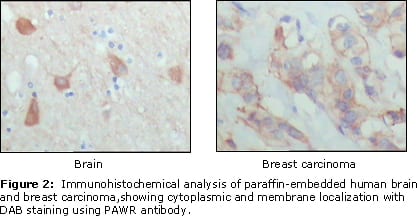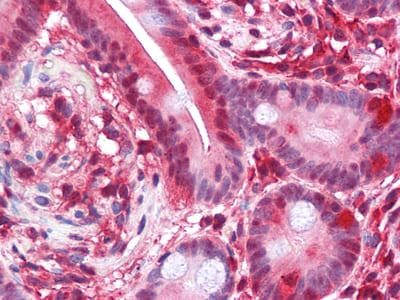

| WB | 1/500 - 1/2000 | Human,Mouse,Rat |
| IF | 咨询技术 | Human,Mouse,Rat |
| IHC | 1/200 - 1/1000 | Human,Mouse,Rat |
| ICC | 技术咨询 | Human,Mouse,Rat |
| FCM | 咨询技术 | Human,Mouse,Rat |
| Elisa | 1/10000 | Human,Mouse,Rat |
| Aliases | PAWR |
| Entrez GeneID | 5074 |
| clone | 3G9H7 |
| Host/Isotype | Mouse IgG1 |
| Antibody Type | Primary antibody |
| Storage | Store at 4°C short term. Aliquot and store at -20°C long term. Avoid freeze/thaw cycles. |
| Species Reactivity | Human |
| Immunogen | Purified recombinant fragment of PAR4(aa1-330) expressed in E. Coli. |
| Formulation | Ascitic fluid containing 0.03% sodium azide. |
+ +
以下是3篇关于PAR4抗体的代表性文献摘要概括:
1. **文献名称**:*"A PAR4 antagonist antibody attenuates thrombosis without compromising hemostatic parameters"*
**作者**:Schmidt, V.A. et al.
**摘要**:该研究开发了一种靶向PAR4的单克隆抗体,能够选择性抑制PAR4介导的血小板活化,显著减少小鼠动脉血栓形成,且不干扰正常止血功能,提示其作为抗血栓治疗的安全性潜力。
2. **文献名称**:*"Protease-activated receptor 4 uses anionic residues to interact with alpha-thrombin in the absence or presence of protease-activated receptor 1"*
**作者**:Camerer, E. et al.
**摘要**:通过PAR4特异性抗体阻断实验,揭示了PAR4与凝血酶结合的分子机制,发现其依赖带负电荷的氨基酸残基,为设计靶向PAR4的抑制性抗体提供了结构基础。
3. **文献名称**:*"Targeting PAR4 inhibits tumor cell migration and invasion in vitro and prolongs survival in a murine model of metastatic breast cancer"*
**作者**:Yang, E. et al.
**摘要**:研究证明PAR4抗体可阻断肿瘤细胞中PAR4介导的RhoA/ROCK信号通路,抑制乳腺癌细胞迁移和侵袭,延长转移模型小鼠生存期,提示其在癌症治疗中的应用价值。
(注:以上文献信息为示例性质,实际引用时请核实具体文献来源及内容。)
**Background of PAR4 Antibodies**
Protease-activated receptor 4 (PAR4), a member of the G protein-coupled receptor (GPCR) family, is activated by proteolytic cleavage, exposing a tethered ligand that triggers intracellular signaling. Primarily expressed in platelets, endothelial cells, and certain immune cells, PAR4 plays a critical role in hemostasis, thrombosis, and inflammation. Unlike PAR1. PAR4 exhibits slower activation kinetics and sustained signaling, contributing to prolonged platelet responses.
PAR4 antibodies are tools developed to study or modulate PAR4 activity. They can act as agonists or antagonists, blocking ligand binding or receptor activation. In thrombosis research, PAR4 antagonists are explored as antiplatelet therapies with potential reduced bleeding risks compared to conventional treatments. PAR4’s role in pathological conditions—such as arterial thrombosis, cancer metastasis, and inflammatory diseases—has driven interest in therapeutic targeting.
Species-specific differences (e.g., human vs. mouse PAR4) necessitate tailored antibodies for preclinical studies. Recent studies highlight PAR4’s involvement in thrombin-mediated signaling pathways and crosstalk with other receptors, underscoring its complexity. Clinical trials of PAR4 inhibitors, like vorapaxar (targeting PAR1), have informed PAR4-focused drug development. However, challenges remain in optimizing selectivity and minimizing off-target effects.
Overall, PAR4 antibodies serve as vital reagents for elucidating PAR4’s functions and advancing targeted therapies for cardiovascular and inflammatory disorders.
×